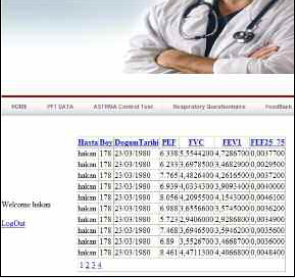By Ali Hakan Işik & İnan Güler
Chronic diseases are long lasting or repetitively occurring diseases that are the leading cause of mortality and disability throughout the world. For instance, chronic diseases account for approximately 80% of deaths in some countries. These diseases include a wide range of health problems which cause negative side effects on a patient’s life. It is important to develop an assessment and management plan with multidimensional and multidisciplinary perspectives in order to provide sustainable treatment for chronic patient care.
Chronic patient care requires more effort but patients are not always compliant. In this context, tele-homecare is a key solution for chronic patient care. One of the main aims of tele-homecare is to provide quality healthcare for patients, especially elderly patients, through advanced technology. The main areas to apply tele-homecare in chronic patient care are diabetes, heart disease and chronic obstructive pulmonary diseases.
Information and communication technologies help to improve the quality and features of tele-homecare. For instance, a mobile device can connect and gather physiological data from ECG, spirometry and pulse oximeter devices, etc. By using wireless technology such as Bluetooth technology, no wires need to be attached to the patient’s body. In this way, the patient is not disturbed and ease of use is improved. As shown in Figure 1, the patient can measure his or her own oxygen saturation and heart rate with a Bluetooth enabled pulse oximeter. In most cases, these data are converted into XML type and transmitted to remote locations by means of a mobile device. In remote locations, all physiological data are stored in a database. These data are evaluated to help aid in decision-making. During the decision- making process, generally, rulebased and heuristic algorithms such as an artificial neural network, a vector support machine is used. When the patient’s physiological data extracted from the decision support system shows the patient’s condition is worsening, an emergency Short Message Service (SMS) is sent. Conversion of the evaluated data result to the SMS XML template is performed on a Web server that is located in a remote location.
In addition, many different kinds of software designed to run on a mobile device have emerged. This easy-to-use mobile assessment tool allows data to be collected daily and facilitates prolonged assessment over time. It also requires less effort. Another important component of tele-homecare is Webbased monitoring of physiological data. As shown in Figure 2, data from a patient’s acceptable pulmonary function test (PFT) result performed at the patient’s home are sent to a remote database. This page provides access to all the patient’s data, so doctors can follow their patients and send an Email or Web-based SMS related to the evaluation of the disease. In this way, statistical data about the development of the disease is easily obtained; as a result, chronic pulmonary patients are more informed and aware concerning their disease, and their quality of life is increased. Lastly, the costs of treatment are reduced.
Tele-homecare systems also provide a significant improvement in reducing the numbers of visits to the doctor’s office, an important figure for health expenditure in the field of chronic patient care. It is believed that tele-homecare provides effective self control and remote management of chronic patients.
This work was supported by Gazi University scientific research project (BAP- 07/2010-55).
Ali Hakan Işik İnan Güler Gazi University Faculty of Technology, Department of Electronics and Computer Technology Turkey ahakan@gazi.edu.tr
About Brenda Wiederhold
President of Virtual Reality Medical Institute (VRMI) in Brussels, Belgium.
Executive VP Virtual Reality Medical Center (VRMC), based in San Diego and Los Angeles, California.
CEO of Interactive Media Institute a 501c3 non-profit
Clinical Instructor in Department of Psychiatry at UCSD
Founder of CyberPsychology, CyberTherapy, & Social Networking Conference
Visiting Professor at Catholic University Milan.











